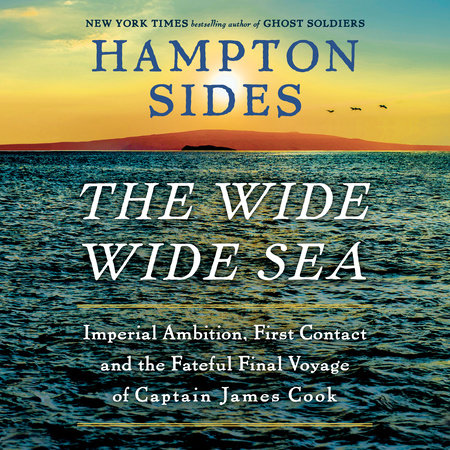Book Review: The Wide Wide Sea by Hampton Sides
(Disclaimer: I received this book through a Goodreads Giveaway for the purpose of writing this review. No other compensation was offered or received.)
Captain James Cook of the British Royal Navy led three exploratory missions, the last of which launched in 1776 and returned in 1780. His primary mission was to explore the upper regions of the northeast Pacific and the edges of the North American continent in order to find the Northwest Passage from the theoretical western end. But along the way the ships encountered many things new to Europeans, including locating the Hawaiian islands. Where Captain Cook died.

This history book is a mostly chronological retelling of that voyage of exploration. It briefly recaps Captain Cook’s life up to that point, which had some remarkable achievements already. Including not losing his men to scurvy, an endemic problem of long sea voyages in this time period. There’s some background on the politics involved in planning the trip and its objectives, and mention of important crew members. For example, ship’s master William Bligh, who would go on to infamy as Captain Bligh of the Bounty.
Also on board was a Polynesian named Mai who’d been brought to England by a previous voyage, enjoyed a life of celebrity for a while, but needed to return home to free his homeland from invaders. By which he meant the Bora Borans. There’s as much about him in this book as the author could find. Mr. Sides is at pains to try to present the native peoples’ point of view whenever possible, but since most of the peoples Cook encountered had only oral traditions until quite a bit later, the source materials are scanty.
Of note is that Captain Cook had his own doubts about the effects his expedition had on the people they were “discovering.” Introducing the concept of firearms, disrupting the local economies, spreading venereal disease…not a good look, to be honest. But even he could not have dreamed of the colonial era to come.
Still, the expedition did produce many impressive achievements, with advances in cartography making it possible to correctly understand more of the Pacific’s geography, and locating new places to land in the vast ocean.
The book also discusses the apparent breakdown of Cook’s personality, becoming more temperamental and tyrannical, harshly punishing his own men and committing atrocities in retaliation for natives walking off with Navy property. In the end, this is what got him killed. Due to one of his ships being damaged, he returned to Hawaii after the expedition already wore out their welcome there. One of their important smaller boats was stolen (presumably for its iron fittings) and Captain Cook decided to kidnap the king as hostage to get it back. The Hawaiians violently objected, as well they might, and Cook wound up dead.
The expedition still went on afterwards, but accomplished little more than verifying previous findings before losing the other captain, Captain Clerke, to tuberculosis; and then was the long trudge home. There’s a little discussion of what happened to some of the expedition members.
The book comes with illustration pages in color, endpaper maps, acknowledgements, footnotes, extensive bibliography, and index.
Captain Cook’s legacy is mixed; he was a great explorer, but made some blunders that foreshadowed the coming disaster of colonialism. Note that this is not a complete biography of James Cook, and the student of history may also want to get one of those to compare.
The tragic ending of Cook’s life makes this book a bit of a depressing read, but it’s well-researched and reasonably even-handed. It’s written for adults but bright high school students should be able to handle it. Recommended for nautical history fans, and those interested in the Age of Exploration.

